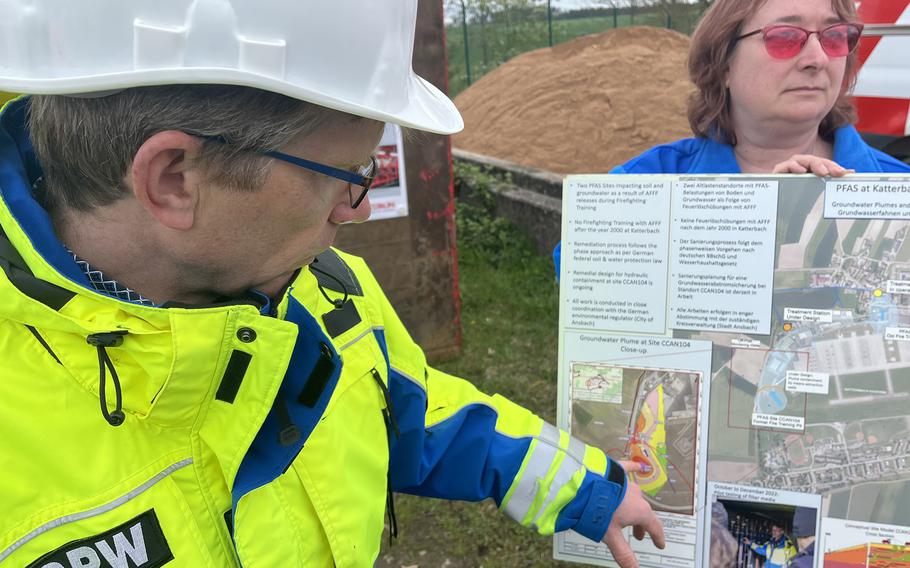
Stephan Haas, remediation program manager at U.S. Army Garrison Ansbach, points to a rendering of a PFAS contamination plume located alongside the garrison's western fence line in Ansbach, Germany on April 10, 2024. (Matthew M. Burke/Stars and Stripes)
ANSBACH, Germany — Crews began constructing a system of pumps and filters at U.S. Army Garrison Ansbach this week to remove toxic “forever chemicals” from the groundwater.
Workers from Züblin, a Stuttgart-based construction and civil engineering firm, began digging trenches Wednesday alongside the base’s western fence line for a hydraulic containment system.
The purification unit is designed to pump groundwater flowing from underneath a former firefighter training site near Katterbach Airfield and extract PFAS chemicals before they are released into the base’s stormwater channels.
The work started the same day the Biden administration established the first legally enforceable national standards for PFAS allowed in drinking water, according to a statement from the Environmental Protection Agency. The EPA says enforcement is expected to reduce exposure for about 100 million people and prevent tens of thousands of serious illnesses and deaths.
The purification system should be completed in October, said Stephan Haas, Ansbach remediation program manager.
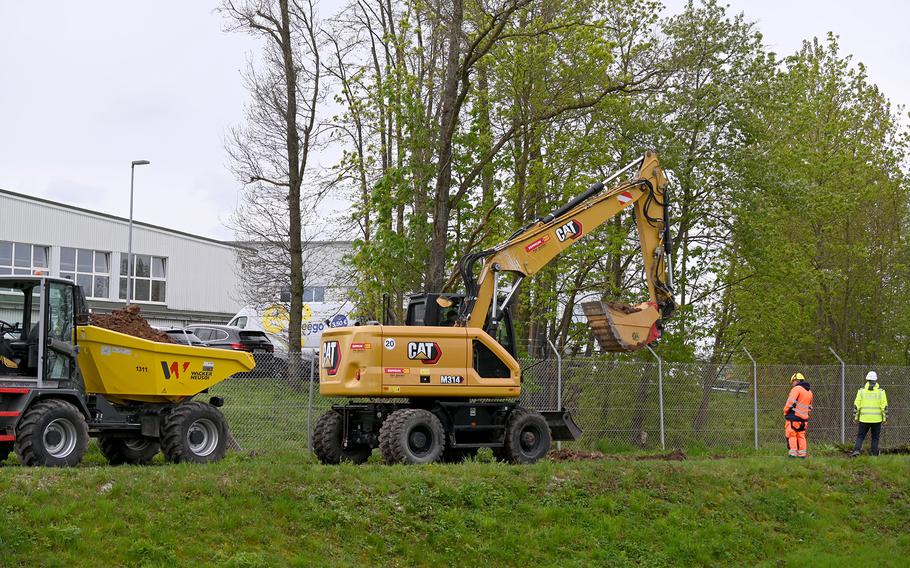
Construction on a new hydraulic containment system designed to remove toxic PFAS chemicals from the groundwater begins at U.S. Army Garrison Ansbach, Germany, on April 10, 2024. (Matthew M. Burke/Stars and Stripes)
“This project is not the final answer” to solve the problem, Haas said Wednesday as shovels pierced a nearby causeway. “It’s one important step to prevent the contaminants from migrating.”
PFAS, or manmade per-and polyfluoroalkyl substances, are used to make coatings and products that resist heat, oil, stains, grease and water, according to the Centers for Disease Control and Prevention.
PFAS compounds accumulate in the body over time and have been linked to a slew of adverse health conditions from increased cholesterol to liver and immune system damage, low birth weight and certain cancers, the CDC website said.
A study published Monday in Nature Geoscience found that nearly a third of 45,000 water samples taken around the world from sources without any readily identifiable source of contamination had PFAS at levels harmful to human health.
The class of chemicals, which includes PFOS and PFOA, were used for many years in firefighting foam expended on U.S. military installations.
The garrison at Ansbach stopped using aqueous film forming foam in 2000, base spokeswoman Gerlinde Hoyle wrote in an emailed statement to Stars and Stripes on Wednesday.
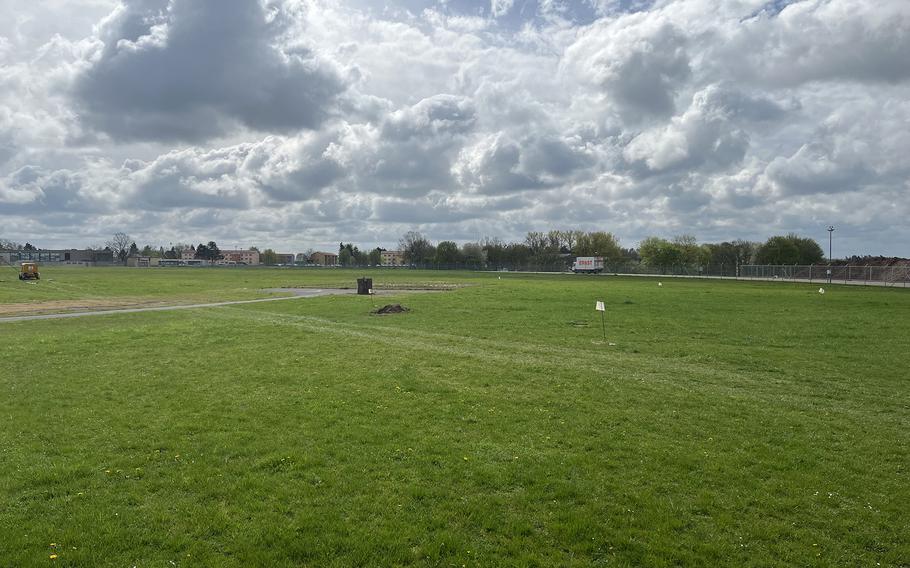
Flags mark planned extraction wells around a concrete pad where firefighter training used to take place at U.S. Army Garrison Ansbach in Germany on April 10, 2024. The area's groundwater is now contaminated with toxic PFAS and must be pumped and purified before it is allowed to flow off base. (Matthew M. Burke/Stars and Stripes)
Under the new EPA guidelines, the enforceable maximums for PFOS and PFOA in drinking water were set to four parts per trillion, or approximately four nanograms per liter, which is close to the chemicals’ lowest detectable levels, the EPA statement said. Three other PFAS chemicals were restricted to 10 parts per trillion.
By comparison, a new German drinking water law in June set a cumulative limit for a group of 20 PFAS substances of 100 nanograms per liter by January 2026 and 20 nanograms per liter for certain chemicals by 2028, according to the country’s environmental protection agency.
Garrison officials did not provide water quality test results when asked this month, instead referring Stars and Stripes to a German-language report on the Ansbach city website.
The U.S. Army report on the website states the entire 226,000 square-foot investigation area, a small fraction of the base’s 15 square miles, registers significant PFAS contamination, including 22,000 nanograms per liter in the groundwater in 2017, and 29,000 two years later.
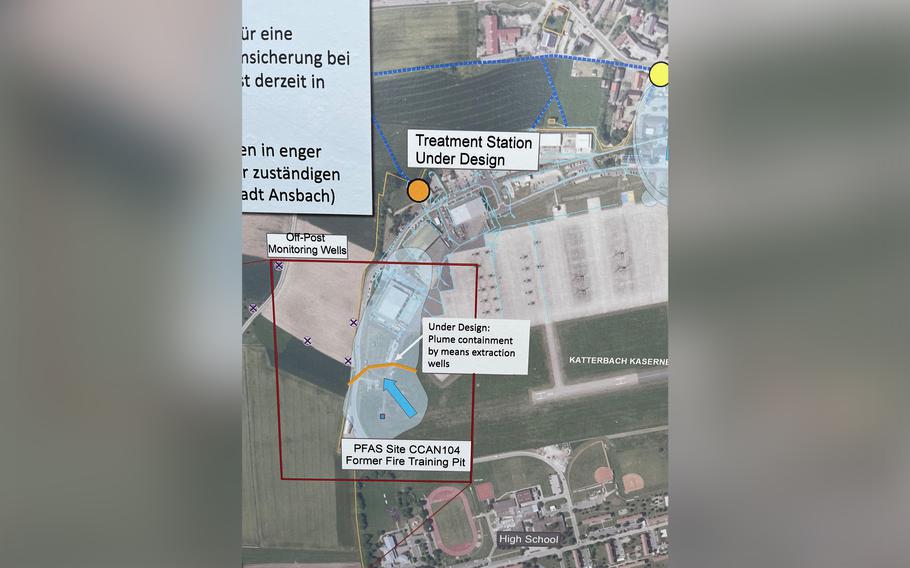
A rendering on display at U.S. Army Garrison Ansbach, Germany, on April 10, 2024, shows the location of a toxic PFAS plume, shaded region inside the red square, and the site of a downstream hydraulic containment system, the orange dot, being built along the base's western fence line. (Matthew M. Burke/Stars and Stripes)
The base’s drinking water supply comes from two local German suppliers and is compliant with German safe drinking water standards, according to a 2021 base consumer confidence report.
Ansbach city officials acknowledged Thursday that elevated levels of PFAS also exist outside the installation fence line, but they remain within safety limits.
The base’s first “pump and treat” system was installed at a northwest site back in 2016, said Jennifer Collins, chief of the garrison’s environmental division.
The latest treatment system, located southwest of the base’s heliport, will have nine extraction wells, nearly a half-mile of piping and granulated carbon filters, a base fact sheet said.
The garrison also plans to address PFAS in the soil as well, but no decisions have yet been made, Haas said.
Stars and Stripes reporter Alexander Riedel contributed to this report.
burke.matt@stripes.com @MatthewMBurke1
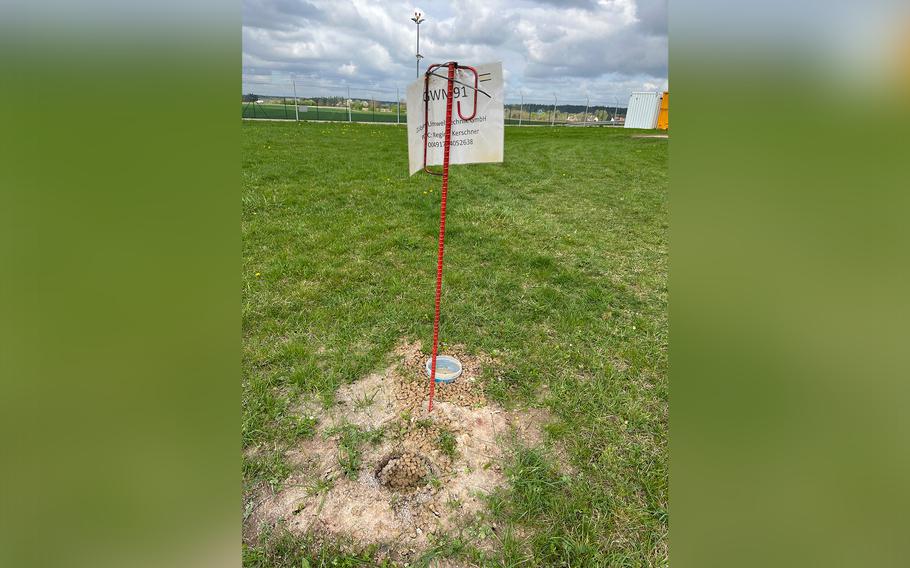
Flags mark planned extraction wells around a concrete pad where firefighter training used to take place at U.S. Army Garrison Ansbach in Germany on April 10, 2024. The area's groundwater is now contaminated with toxic PFAS and must be pumped and purified before it is allowed to flow off base. (Matthew M. Burke/Stars and Stripes)